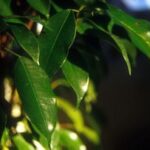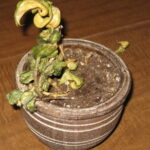Ficus have been around as houseplants for well over one hundred years now and their popularity shows no signs of waning. They tend to be easy to care for, happy plants and many of them are big enough to really make a decorative statement.
The ficus family includes the edible fig (‘ficus’ means ‘fig’ in Latin) but that plant *isn’t* one that makes a good houseplant. The genus has over 800 species in it, with widely varying forms, from giant tree to tiny crawling vine. Most of them want the same conditions, though.
Ficus want plenty of light, but not direct sunlight. Those with variegated foliage need more light than those with solid green leaves, and I’ve found that my ‘Burgundy’ F. elastica reverts to dark green rather than its dark maroon color when it’s not getting enough light. They are happy at the temperatures that people are happy at, although the hotter the room is the bigger the risk of getting spider mites is. Most species should be grown a bit on the dry side; allow the top half of the soil to dry out between waterings. Over watering can cause leaf drop. Give a regular houseplant fertilizer every two weeks in spring and summer, but no fertilizer in fall and winter. The plants may be evergreen, but they still have a dormant period. Plants don’t need repotting until a number of roots start growing out the drainage holes of the pot; they appreciate being root bound. The varieties of ficus that have shiny foliage should have their leaves wiped down- gently! – with a sponge or soft rag. Do not use milk or the commercial leaf polish; the oils in the can clog the leaf pores and they attract dust faster in the long run. All the ficus tend to drop their leaves when they are moved or there is sudden change in temperature, light, or humidity.
Ficus elastica is the traditional rubber plant, with large, shiny oval leaves. Its natural habit is to grow a single stem straight up, but if you cut it off it will branch out. Have some powdered charcoal or some ash handy to put on the cut end, because it will ‘bleed’ copiously. This plant frequently needs staking when it’s young, before the stems get thick enough to hold itself up. There are a number of varieties of f. elastica, including variegated ones and the one I love, ‘Burgundy’.
Ficus benjamina aka Weeping Fig is the next best known of the genus. With woody stems and small leaves, it doesn’t look like my idea of a fig. This is the plant you see in a lot of public places, sometimes with braided trunks- I call it the Shopping Mall Tree because it shows up so often there. This one is prone to scale infestations, which are difficult to cure. I’ve had the best luck with a combination of a thorough washing with water and a systemic worked into the soil. There is a variegated version that doesn’t get as large- or at least not as fast- as the plain leaf one. These drop a few leaves frequently; only be concerned if they drop a lot of them at one time.
Ficus lyrata is the most impressive of the indoor figs in my opinion. The leaves are dull, huge – up to 15 inches long- and are pinched in the middle so that they look like cellos. Like f. elastica it will grow in a single stem if not cut to force branching. This one hates cold temperatures, cold water and chlorine- use warm water that has stood for a few hours to let the chlorine off gas. It’s worth the fuss, as it’s truly an ‘Oh, WOW!” plant.
Ficus pumila goes the other direction in size- it’s a tiny, creeping vine. It has thin stems and little heart shaped leaves. This one is pickier about conditions than the large ones. It can’t be allowed to dry out, ever. If it does, it doesn’t just drop its leaves, it dies. Mine is hanging over the kitchen sink so water is always handy. Even so, when winter comes and the air gets drier, it loses a lot of leaves. It comes in a variegated from, which is what I have. Keep watch for stems with all green leaves. These have to be cut off or the entire plant will end up solid green as the green branches will grow faster and leave less nourishment for the weaker, slower growing variegated parts. A pain? Somewhat, but it’s just so cute it’s worth it.
There are other ficus that can be used as houseplants including Bo Trees, but these are both the most common and the most suited for a household use. Except for the f. pumila, they can be found at most garden centers. They grow swiftly, so you can buy small, inexpensive plants and they’ll be an impressive size in a couple of years. Altogether a most impressive genus.




